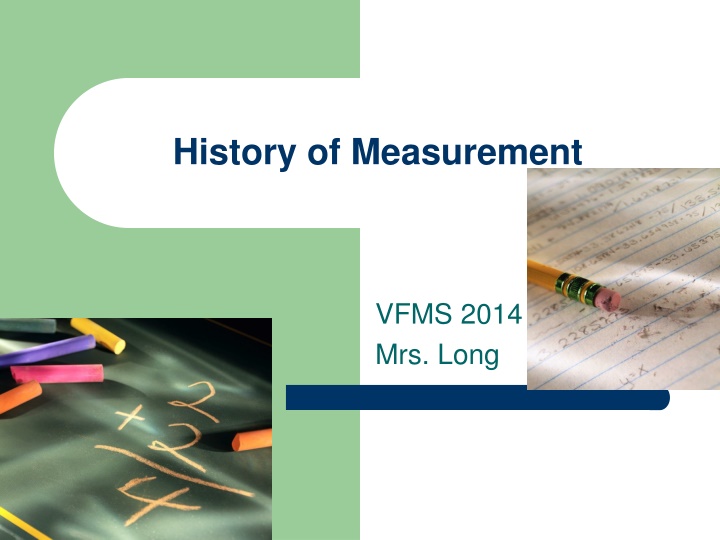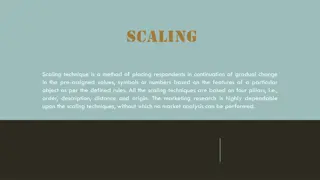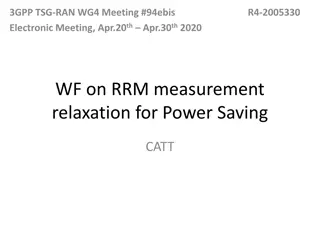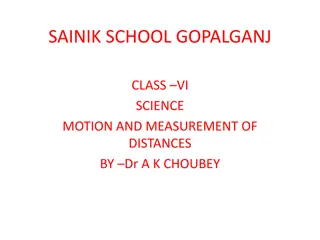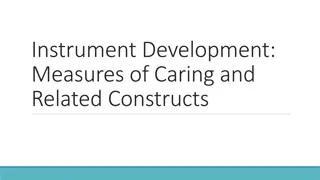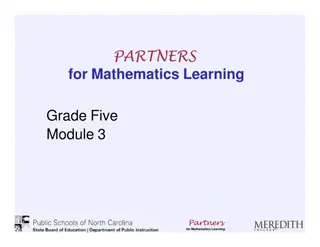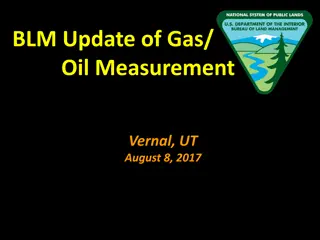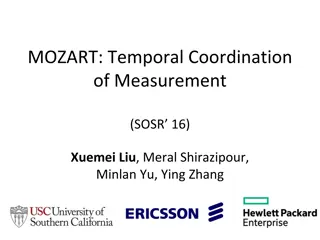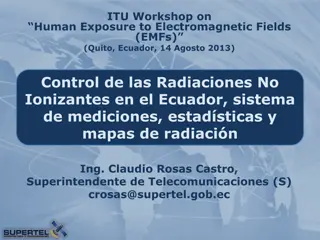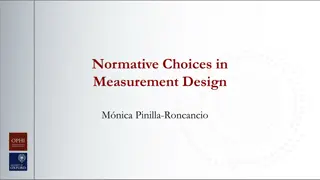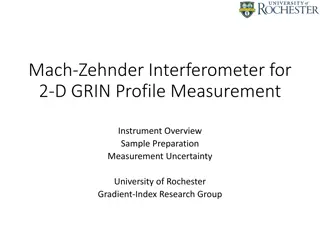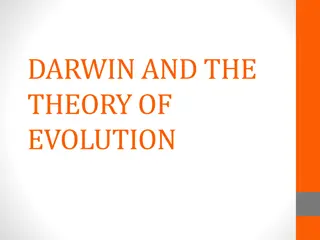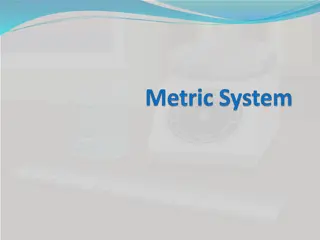Evolution of Measurement Systems Over Time
Explore the fascinating journey of measurement systems from historical units like cubit and fathom to the modern metric system. Discover how civilizations developed standardized units for length, weight, and mass. Follow the timeline of measurement advancements, from King Edward's iron ulna to the birth of the metric system in 1793. Learn about fundamental units of measurement and the implementation of the Systeme International (SI System) in 1960, providing a universal language for scientific practices. Delve into the metric system's base units, prefixes, and conversion methods for practical application.
Download Presentation

Please find below an Image/Link to download the presentation.
The content on the website is provided AS IS for your information and personal use only. It may not be sold, licensed, or shared on other websites without obtaining consent from the author.If you encounter any issues during the download, it is possible that the publisher has removed the file from their server.
You are allowed to download the files provided on this website for personal or commercial use, subject to the condition that they are used lawfully. All files are the property of their respective owners.
The content on the website is provided AS IS for your information and personal use only. It may not be sold, licensed, or shared on other websites without obtaining consent from the author.
E N D
Presentation Transcript
History of Measurement VFMS 2014 Mrs. Long
Measurement Notes I. Historical units of measurement Length 1. Cubit = distance from the tip of the elbow to the tip of the middle finger. 2. Fathom = distance across a man s outstretched arms. 3. Span distance from pinky to thumb on an outstretched hand. 4. Digit length of one finger.
Measurement Notes Weight Babylonians improved upon the invention of the balance by establishing the world s first weight standards polished stones! Egyptians & Greeks used a wheat seed as the smallest unit of weight.
II. Timeline of measurement Thirteenth century King Edward of England, realized the importance of standardization ordered the iron ulna . 1793 Napoleon s rule of France, the metric system was born! Based on the meter supposed to be one-ten millionth (1/10,000,000 ) of the Earth s circumference (measured at 40,000 km)
II. Timeline of measurement 1960 Officially adopted Systeme International (SI System) need for universal language in sciences recognized. Decimal system is based on units of 10. Today Accepted & used worldwide by scientist
III. Fundamental Units of Measurement Quantity Unit Symbol Length meter m Mass gram g Volume liter l Time second s Force newton N Energy joule J
Metric System The metric system is based on a base unit that corresponds to a certain kind of measurement Length = meter Volume = liter Weight (Mass) = gram Prefixes plus base units make up the metric system Example: Centi + meter = Centimeter Kilo + liter = Kiloliter
IV. Using the Metric System To convert to a smaller unit, move the decimal point to the right or multiply. To convert to a larger unit, move the decimal point to the left or divide. KING HENRY DECKED BULLIES DRINKING CHOCOLAT MILK E Kilo Hecto Deka Base Unit deci centi milli K Volume: liter (l) Distance: Meter (m) Mass: gram (g) 1.0 H D d c m 1000.0 100.0 10.0 0.1 0.01 0.001 Bigger Smaller
Metric System The three prefixes that we will use the most are: kilo centi milli Base Units meter gram liter Giga G MEGA M HECTO h DECA D deci d micro nano n KILO k centi c milli m smaller than base unit LARGER than base unit
Metric System These prefixes are based on powers of 10. What does this mean? From each prefix every step is either: 10 times larger or 10 times smaller For example Centimeters are 10 times larger than millimeters 1 centimeter = 10 millimeters Base Units meter gram liter GIGA G MEGA M HECTO h DECA da deci d micro nano n KILO k centi c milli m
Metric System If you move to the left in the diagram, move the decimal to the left If you move to the right in the diagram, move the decimal to the right meter liter gram kilo centi milli hecto deca deci
Example #1 13.2 mg = ? g Step 1: Identify that mg < g Step 2: slide decimal point to the left 3 times 13.2 mg Step 3: put a 0 in front of the decimal and add correct unit to the number 0.0132 g
Example 2 5.7 km = ? cm Step 1: Identify that km > cm Step 2: slide decimal point to the right 5 times because kilometers are 5 units larger than centimeters 5.7 km Step 3: put four 0 s in behind the 7 and add the correct unit to the number 570,000 cm
Metric System Now let s start from meters and convert to centimeters 5 meters = _____ centimeters 500 meter liter gram kilo centi milli hecto deca deci Now let s start from kilometers and convert to meters .3 kilometers = _____ meters 300 meter liter gram kilo centi milli hecto deca deci
Metric System Review What are the base units for length, volume and mass in the metric system? What prefix means 1000? 1/10?, 1/1000? How many millimeters are in 12.5 Hm? How many Kiloliters are in 4.34cl? meter liter gram kilo centi milli hecto deca deci
Metric System Now let s start from meters and convert to kilometers 4000 meters = _____ kilometers 4 meter liter gram kilo centi milli hecto deca deci Now let s start from centimeters and convert to meters 4000 centimeters = _____ meters 40 meter liter gram kilo centi milli hecto deca deci
V. Accuracy vs. Precision 1. Accuracy nearness of a measurement to the standard or true value. Precision the degree to which several measurements provide answers very close to each other. 3. Percent error: a measure of the % difference between a measured value and the accepted correct value formula: | correct measured | x 100 = % error correct 2.
VI. Significant Figures- Certain vs. Uncertain Digits: Certain DIGITS THAT ARE DETERMINED USING A MARK ON AN INSTRUMENT OR ARE GIVEN BY AN ELECTRONIC INSTRUMENT Uncertain THE DIGIT THAT IS ESTIMATED WHEN USING AN INSTRUMENT WITH MARKS (ALWAYS A ZERO OR FIVE FOR THIS CLASS)
Significant figures Rules Numbers other than zero are always significant 96 ( 2 ) One or more zeros used after the decimal point is considered significant. 4.7000 ( 5 ) Zeros between numbers other than zero are always significant. 5.029 ( 4 ) 450.089 ( 6 ) 61.4 ( 3 ) 32 ( 2 )
Zeros used at the end or beginning are not significant. The zeros are place holders only. 75,000 ( 2 ) Rule for rounding-If the number to the right of the last significant digit is 5 or more round up. If less than 5, do not round up. Need 2 sig figs. For this value 3420 (3400 ) Need 3 sig figs. For this value 0.07876 ( 0.0788) 0.00651 ( 3 )
Significant Figures Number Number of Sig Figs 3 3 3 3 5 3 3 ? Digits in a measured number that include all certain digits and a final digit with some uncertainty 9.12 0.192 0.000912 9.00 9.1200 90.0 900. 900
Addition and Subtraction- answer may contain only as many decimals as the least accurate value used to find the answer. 33.014+ 0.01 = Multiplication and Division- answer may contain only as many sig. Figs. As the smallest value used. 33.02 3.1670 x 4.0 = 12.668 13
Example State the number of significant figures in the following set of measurements: a. 30.0 g b. 29.9801g d. 31,000 mg e. 3102. cg c. 0.03 kg
VII. Scientific Notation Scientific notation Representation of a number in the form A x 10n Scientists work with very large and very small numbers. In order to make numbers easier to work with, scientists use scientific notation. Scientific notation- there must always be only one non-zero digit in front of the decimal.
In scientific notation, the number is separated into two parts. The first part is a number between 1 and 9. The second is a power of ten written in exponential form. Examples: 100= 10x10= 102 1000= 10x10x10=103 0.1=1/10=10-1 .01=1/100=1/10x1/10=10-2
Converting numbers to Scientific notation To write numbers in scientific notation, the proper exponent can be found by counting how many times the decimal point must be moved to bring it to its final position so that there is only one digit to the left of the decimal point (the number is between 1 and 9). A(+) positive exponent shows that the decimal was moved to the left. It is moved to the right when writing the number without an exponent. A (-) negative exponent shows that the decimal was moved to the right. It is moved to the left to get the original number.
Another method of deciding if the exponent is positive or negative is to remember that values less than one (decimals) will have negative exponents and values of one or greater than one have positive exponents. Examples: 920=9.2x100=9.2x102 1,540,000=1.54x1,000,000=1.54x106 83500=8.35x10,000=8.35x104 0.018=1.8x.01=1.8x10-2
Scientific Notation Representation of a number in the form A x 10n Number 0.000319 3,190,000 0.000000597 Scientific Notation 3.19x10-4 3.19x106 5.97x10-7
Scientific Notation Computation Rules: Addition and Subtraction: 1.make the exponents match 2.add or subtract the coefficients 3.keep the exponent the same for the answer 4.correct the S.N. if it is not in the correct format 2x103+3x103 = 1.5x103 + 2.6x104 =
Scientific Notation Computation Rules: Multiplication and Division: 1. multiply or divide the coefficients 2. add the exponents (for multiplication) or subtract the exponents (for division) 3. correct the S.N. if it is not in correct format 1x102 X 1.2x105 X 2.3x10-1 1.7x103 7.3x10-4/ 4.2x102 =
Tools of Measurement Measuring Length Ruler Using the METRIC side Record all certain digits PLUS one uncertain (record to the hundredths place) Units: cm, mm, m, km
Measuring Mass Triple beam balance Uses three (sometimes 4) beams to measure the mass of an object Place solid object directly on pan Place powders on filter paper or liquids in a container; deduct mass of the paper or container from the final measurement Start with riders at largest mass and work back until the pointer reaches zero Record all certain (up to hundredths) plus one uncertain (thousandths)
Measuring Volume Solids - Ruler Volume = length x width x height Units: cubic centimeter = cm3 Liquids Graduated Cylinder Read the volume at the bottom of the meniscus Be sure to place the graduated cylinder on a flat surface and look straight at the meniscus Caution: Be sure to determine the increments on the graduated cylinder Record all certain (usually tenths) plus one uncertain (usually hundredths) Units: generally ml
Unusually Shaped Objects Water Displacement Determine the volume of a filled graduated cylinder Place the object in the graduated cylinder Determine the volume of the graduated cylinder with the object Subtract the volume to determine the amount of water displaced the volume of the solid
Measuring Temperature Thermometer Read the level of alcohol in the tube to determine the temperature Caution: When reading negative temperatures be sure that you are reading in the correct direction Units: degrees Celsius 25 ( F) 25 ( C) Temperature ( C) 30 is hot 20 is nice 10 is chilly 0 is ice
The Metric System: Conversions (APPROXIMATE) Metric 1 kilogram 1 kilometer 1 meter 1 centimeter 1 liter 1 liter English 2.2 pounds 0.62 miles 1.09 yards 0.39 inches 1.06 quarts 0.26 gallons
